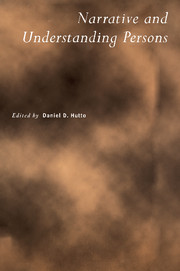Book contents
- Frontmatter
- Contents
- List of Contributors
- Notes on Contributors
- Narrative and Understanding Persons
- Framing Narratives
- The Narrative Practice Hypothesis: Origins and Applications of Folk Psychology
- Dramatic Irony, Narrative, and the External Perspective
- Episodic Ethics
- On the Distance between Literary Narratives and Real-Life Narratives
- Reasons to be Fearful: Strawson, Death and Narrative
- Stories, Lives, and Basic Survival: A Refinement and Defense of the Narrative View
- Self and Other: The Limits of Narrative Understanding
- Pathologies in Narrative Structures
Pathologies in Narrative Structures
Published online by Cambridge University Press: 04 May 2010
- Frontmatter
- Contents
- List of Contributors
- Notes on Contributors
- Narrative and Understanding Persons
- Framing Narratives
- The Narrative Practice Hypothesis: Origins and Applications of Folk Psychology
- Dramatic Irony, Narrative, and the External Perspective
- Episodic Ethics
- On the Distance between Literary Narratives and Real-Life Narratives
- Reasons to be Fearful: Strawson, Death and Narrative
- Stories, Lives, and Basic Survival: A Refinement and Defense of the Narrative View
- Self and Other: The Limits of Narrative Understanding
- Pathologies in Narrative Structures
Summary
Per Aage Brandt, commenting on a passage from Merlin Donald, suggests that there is ‘a narrative aesthetics built into our mind.’ In Donald, one can find an evolutionary account of this narrative aesthetics. If there is something like an innate narrative disposition, it is also surely the case that there is a process of development involved in narrative practice. In this paper I will assume something closer to the developmental account provided by Jerome Bruner in various works, and Dan Hutto's account of how we learn narrative practices, and I'll refer to this narrative aesthetics as a narrative competency that we come to have through a developmental process. I will take narrative in a wide sense, to include oral and written communications and self-reports on experience. In this regard narrative is more basic than story, and not necessarily characterized by the formal plot structure of a story. A story may be told in many different ways, but always via narrative discourse. Also, having narrative competency includes not just abilities for understanding narratives, but also for narrative understanding, which allows us to form narratives about things, events and other people. To be capable of narrative understanding means to be capable of seeing events in a narrative framework.
The questions that I want to explore are these: what are the cognitive elements that contribute to the development of narrative competency? What do we gain from the deployment of this narrative competency?
- Type
- Chapter
- Information
- Narrative and Understanding Persons , pp. 203 - 224Publisher: Cambridge University PressPrint publication year: 2007
- 6
- Cited by



